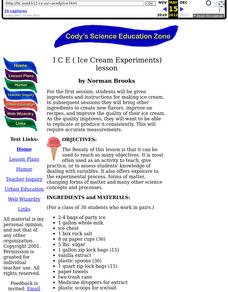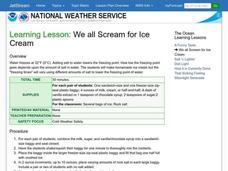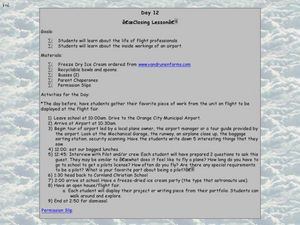Curated OER
Ice Cream
Young scholars explore the concept of the colligative property. Through experimentation, students lower the freezing point of a liquid in order to create a solid by using household ingredients to create ice cream.
Curated OER
I C E ( Ice Cream Experiments) Lesson
Learners make ice cream. They use the experimental process to improve the ice cream working with variables in the recipes.
Curated OER
It's All in the Measurements
Study customary measurements with your sixth graders. They will investigate linear and capacity measurements to then measure and convert linear and capacity units. Finally they will work in small groups to conduct experiments. Resources...
Curated OER
Ice Cream Chemical and Physical Changes
Fourth graders identify characteristics of a simple physical and chemical change. They describe objects by the properties of the materials from which they are made and that these properties can be used separate. Students describe the...
Curated OER
What's The Scoop?
Students explore the properties of matter. In this cross curriculum three states of matter science lesson, students listen to the poem "Eighteen Flavors" by Shel Silverstein, and predict what will happen if listed ingredients are...
Curated OER
Understanding the Effects of Salt on Ice
Students explore the concept of freezing point in an experiment that shows why salt is effective at clearing ice from roadways in the winter. In small groups, they compare the process of making homemade ice cream in plastic bags with and...
Curated OER
The Frigid Gourmet
High schoolers make a " science surprise" or ice cream in the lab. In this melting point depression lesson plan, students use various substances with ice to determine the effects on the melting point of ice and the ability to make ice...
Curated OER
Solar Matters II- Ice Cube Race
Students discuss the methods of energy transfer. In this energy transfer lesson, students use ice to demonstrate what happens when energy is transferred. Students complete a Science Journal page as an assessment.
Curated OER
Snack Smart, Move More
What do lowfat yogurt, baby carrots, fresh fruit, and rice cakes have in common? They are all healthy snacks that can be eaten daily. Investigate healthy eating/snacking guidelines, learn how to make lowfat ice cream and practice some...
Curated OER
Ice Cream Science
Students review properties of matter and discuss how materials change when things are done to them. They observe how materials change as a reaction to temperature by following the procedure to make ice cream and recording the temperature...
Curated OER
We All Scream for Ice Cream
Students make ice cream while experimenting with the freezing point of water. They experiment with different amounts of salt.
Council for Economic Education
I'll Trade You a Bag of Chips, Two Cookies, and $60,000 for Your Tuna Fish Sandwich
If you are looking for a great lesson plan on supply, demand, market price, demand curves, and data analysis look no further. With glossary definitions, activities, and web lined resources this lesson plan is a winner.
Starry Night Education
Comets and Meteors
Comets are also known as dirty snowballs or icy mud balls. With your super scientists, create a model comet nucleus to discover how they are made and take part in a scientific discussion to learn how it behaves.
Curated OER
State Change
Eighth graders explore the physical change of matter. As a class, they discuss their favorite super hero and determine if the hero undergoes a physical or chemical change. Students examine the change of state and phase change. In groups,...
Curated OER
Phase Change
Students compare the freezing temperature of two substances by conducting an experiment to freeze liquid ice cream. They vary the amount of salt used in the ice cubes during the freezing procedure to determine the change in the...
Curated OER
I Wood if I Could
Tenth graders investigate the process of how specific products are made from trees. For this chemistry lesson, groups of students must choose among ice cream, bubble gum, paper, toothpaste and lipstick. They research, design and...
Curated OER
What Is the Matter with Water?
Second graders observe matter in all 3 states : liquid, solid and gas, in an ice cream soda. In teams, they are given ice and teams compete to be the first to melt their ice. Winner gets the ice cream soda. They draw examples of 3 states...
Curated OER
Printing Practice Letter P
In this printing worksheet, students trace 4 uppercase letter P's. The first box provides arrows that guide students in tracing the letter.
Curated OER
Nutrients by the Numbers
Learners read and discuss an article on the amount of sugar in various food products. They compare the nutritional values of food products, calculate their daily intake of nutrients, analyze serving sizes, and compare/contrast their own...
Curated OER
Heat Transfer & Phase Changes
In this heat transfer and phase change worksheet, students experiment with ice, salt, and milk to show the relationship between the temperature of a solution and its phase. Students turn milk from a liquid to a solid and graph the...
Curated OER
Charts and Graphs
Fifth graders interpret data into graphs and percentages. In this organizing data lesson, 5th graders discuss bar, circle and line graphs. Students complete bar graph and apply probability using the results.
Curated OER
Day 12: Airport
Students take a field trip to a local airport. In this final flight instructional activity, students take a class field trip to the local airport. They tour the airport with the manager, observing the runway, an airplane, and security...
Curated OER
Getting the Most From Your Food
Students study the food pyramid to learn about healthy food. In this healthy foods lesson plan, students create a chart of the healthy foods they eat in a day. Students discuss their choices and how they could make better...
Curated OER
Classification
Students investigate how different types of food can be classified then counted. In this sorting, arranging, and classifying lesson plan, students explore how to group foods based on commonalities. Students are asked four questions which...

























